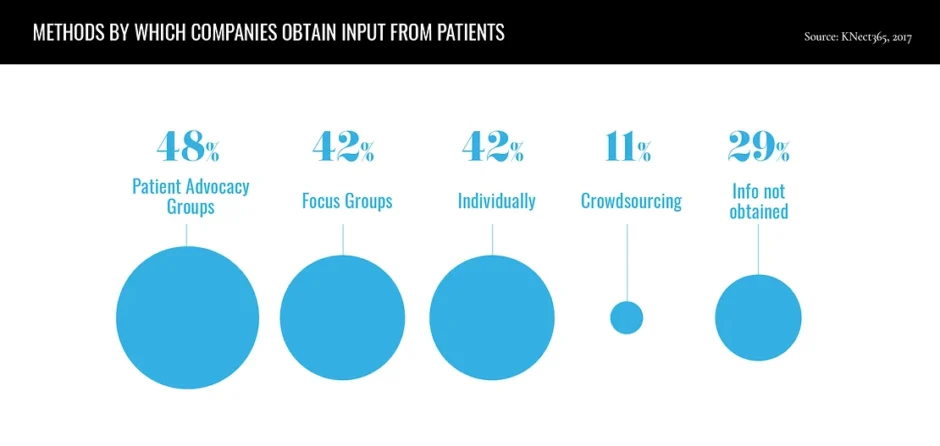Words by James Coker
The increasing focus on patient centricity in recent years has ensured pharmaceutical companies are far more in sync with the issues that patients’ face on a day-to-day basis than ever before; however, translating these insights into treatment improvements remains a challenge. As the march towards putting the patient voice at the heart of their care continues, new ways of thinking about drug development are needed to more effectively tackle the issues that most concern patients.
New ways of thinking about drug development are needed to tackle the issues that concern patients
Involving patients as a direct partner in R&D is a relatively new phenomenon and a direct consequence of a ‘patient first’ culture being instilled throughout the industry. “At Pfizer we’ve chosen to make that a cultural imperative. Our focus is patient first, and we’re engraining that into every fibre of our entire organisation. And when we do that, you’d be amazed at the innovation and creativity that comes”, says Michael Gladstone, President of Internal Medicine, Pfizer, during a panel discussion at the 2018 FT Global Pharmaceutical and Biotechnology Conference.
This approach has led to a whole new understanding of patient experiences, which has highlighted that traditional measures of patient-reported outcomes (PROs) can be insufficient in many circumstances. A collaborative project involving Pfizer found that patients often express pain in ways that quantitative measures are simply unable to describe. “When you think about pain, what do you think of: what’s your number on the scale 1–10? It doesn’t really illustrate what’s going on. One of the patients asked: ‘what’s the number for sitting in my bed crying for 30 minutes, and not being able to get out of bed?’” comments Gladstone.
This poignant example illustrates the scale of the challenge faced in converting these different patient stories into accurate PRO measurements. It is a key issue that must be addressed for the development of suitable measuring criteria, and one which Hans-Georg Eichler, Senior Medical Officer, EMA is keen to emphasise: “As regulators, as payers, and also as industry, we have to see how we can instil those individual patient stories and make them into what you call a metric; that is not trivial and it is what has given all these outcome measures and their patient involvement in the past a bad name, because you have one anecdote and then you have a completely different anecdote. But we have to make a reproducible and reasonable decision for a population.”
Julie Gerberding, EVP and Chief Patient Officer, Strategic Communications, Global Public Policy and Population Health, MSD, adds: “The science of PROs and benefit-risk requires a different methodology than we would normally use for biostatistical and epidemiological model in randomised clinical trials: it’s much more about social behavioural research.”
The topic has arguably been overlooked in the whole spectrum of patient centricity. There are similarities to the current predicament of attempting to create a Brexit deal that satisfies all parties: addressing the varying reasons why people voted leave while still taking into account the preferences of the large minority of remain voters.
A more flexible, pragmatic strategy in clinical trials could help matters; this includes using information garnered from patient preference studies to supplement decisions made during trials, such as whether the benefits of a drug outweigh any emergent risks. “We can’t fully replace the objective measures, but I think the idea is to supplement our decisions, not just for approval, but our decisions internally from the very beginning to when we’re just looking at what types of field we should go into in terms of research all the way through to when we have the product and are trying to make compassionate use decisions or benefit-risk decision”, comments Joanne Waldstreicher, Chief Medical Officer, Johnson & Johnson.
If we stay in our silos and think only about our medicines and stay in our regulatory lane, we won’t look outside of the way we do things today
This approach requires a high level of collaboration between various stakeholders, with industry, patients, doctors, investigators, and regulators working in harmony. This will not be easy to achieve, not least because of the potential of extra uncertainty and complexity in the regulatory environment. Nevertheless, if the growing emphasis on patient centricity is to translate into patient-centred outcomes, out-of-the-box thinking is required. “It’s going to require all the players to be a bit flexible; if we stay in our silos and think only about our medicines and stay in our regulatory lane, we won’t look outside of the way we do things today. The bottom line is we’ve got to come together and find a way to learn from each other and put the patient front and centre”, concludes Gladstone.










